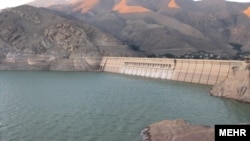WASHINGTON —
A looming water crisis in Iran has officials warning of water rationing for the capital Tehran. The Mehr news agency quotes Khosro Erteghaei, the head of Tehran’s regional water company as saying water levels at the four reservoirs that serve Tehran are at a critical level. He warns that if residents of Tehran and nearby provinces do not reduce their consumption “we will have a problem.”
Officials say if water consumption is not cut back they will consider options such as scheduling water outages for high consuming households, and lowering water pressure in Tehran’s pipeline network that serves an estimated 22 million people.
It’s not only Tehran that is facing a water crisis.
The deputy head of Iran’s water and sewage company recently warned that “500 cities in Iran are facing a water crisis.” In early February, Iran’s energy minister Hamid Chitchian said the country's water supply has dropped by 20-percent over the past year.
The crisis is also affecting Iran’s lakes and rivers. Rivers in central Iran near Isfahan and Ahvaz close to the Persian Gulf have dried up. Hamoun Lake near the Afghan border is now a dustbowl. Lake Urmia, one of the largest salt-water lakes in the world has dropped about 200-meters, and winds blowing dry salt from the lake bed could contaminate nearby agriculture, threatening the livelihoods of an estimated three million people who live nearby.
UN officials say dust from dried up rivers and lakes is already contributing to air pollution levels in Iranian cities, four of which are classified belonging to the 10 most polluted cities in the world.
The government’s response has not been welcomed by the public. In March officials decided to raise water prices by 20-percent.
Experts blame climate change, desertification, poor water management and Iran’s propensity to build dams for the problem. The private intelligence company Stratfor noted in a recent report that Iran’s rainfall rate is also only about one-third to one-fourth of the global average.
Stratfor says more than 70 percent of Iran’s precipitation evaporates and that 50 percent of Iran’s water supply also comes from fast-shrinking underground water supplies which have been poorly managed.
As the crisis grows so do the dangers of social unrest.
Last year Al Monitor, a web site focusing on the Middle east, reported that hundreds of farmers in Isfahan province destroyed a pipeline in clashes with police that was carrying water away from a nearby river to the town of Yazd. And former Agriculture minister Issa Kalantari last year told the Ghanoon newspaper that Iran’s water crisis is more of a threat to the country than “Israel, America or political infighting” among Iran’s political classes.
Officials say if water consumption is not cut back they will consider options such as scheduling water outages for high consuming households, and lowering water pressure in Tehran’s pipeline network that serves an estimated 22 million people.
It’s not only Tehran that is facing a water crisis.
The deputy head of Iran’s water and sewage company recently warned that “500 cities in Iran are facing a water crisis.” In early February, Iran’s energy minister Hamid Chitchian said the country's water supply has dropped by 20-percent over the past year.
The crisis is also affecting Iran’s lakes and rivers. Rivers in central Iran near Isfahan and Ahvaz close to the Persian Gulf have dried up. Hamoun Lake near the Afghan border is now a dustbowl. Lake Urmia, one of the largest salt-water lakes in the world has dropped about 200-meters, and winds blowing dry salt from the lake bed could contaminate nearby agriculture, threatening the livelihoods of an estimated three million people who live nearby.
UN officials say dust from dried up rivers and lakes is already contributing to air pollution levels in Iranian cities, four of which are classified belonging to the 10 most polluted cities in the world.
The government’s response has not been welcomed by the public. In March officials decided to raise water prices by 20-percent.
Experts blame climate change, desertification, poor water management and Iran’s propensity to build dams for the problem. The private intelligence company Stratfor noted in a recent report that Iran’s rainfall rate is also only about one-third to one-fourth of the global average.
Stratfor says more than 70 percent of Iran’s precipitation evaporates and that 50 percent of Iran’s water supply also comes from fast-shrinking underground water supplies which have been poorly managed.
As the crisis grows so do the dangers of social unrest.
Last year Al Monitor, a web site focusing on the Middle east, reported that hundreds of farmers in Isfahan province destroyed a pipeline in clashes with police that was carrying water away from a nearby river to the town of Yazd. And former Agriculture minister Issa Kalantari last year told the Ghanoon newspaper that Iran’s water crisis is more of a threat to the country than “Israel, America or political infighting” among Iran’s political classes.








